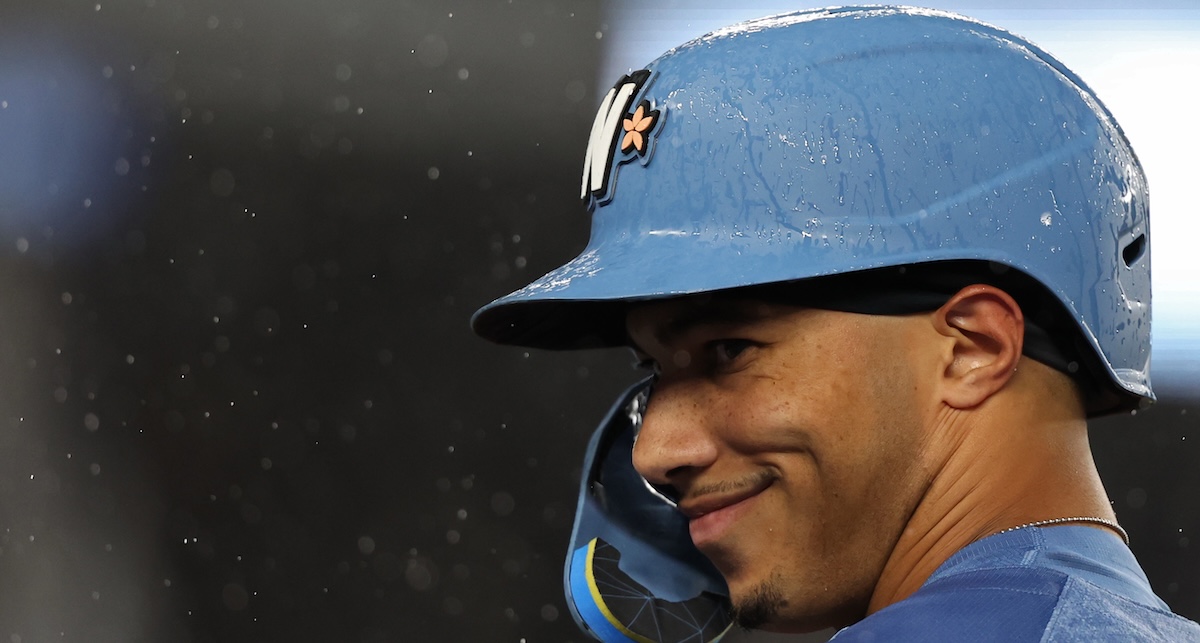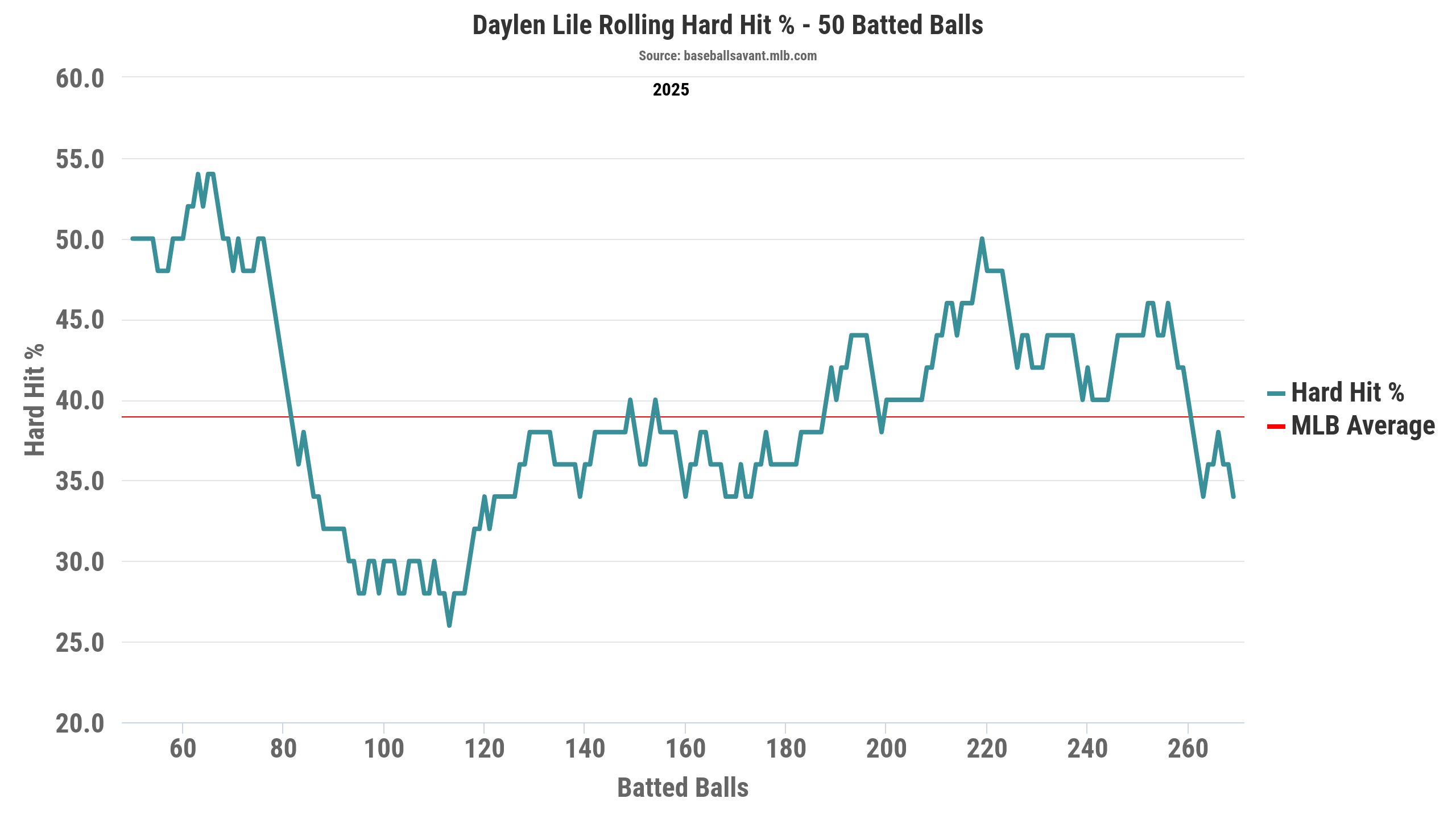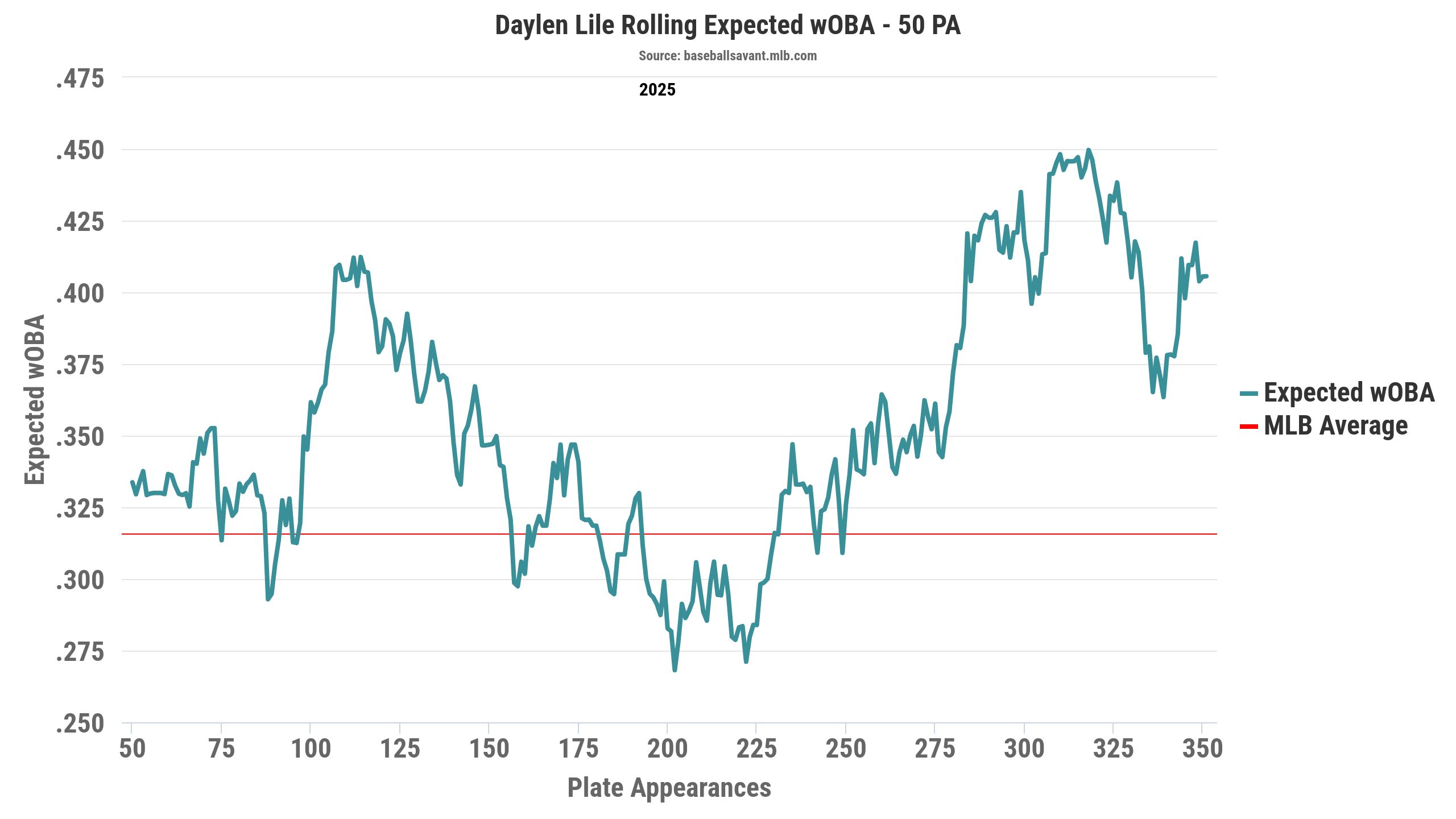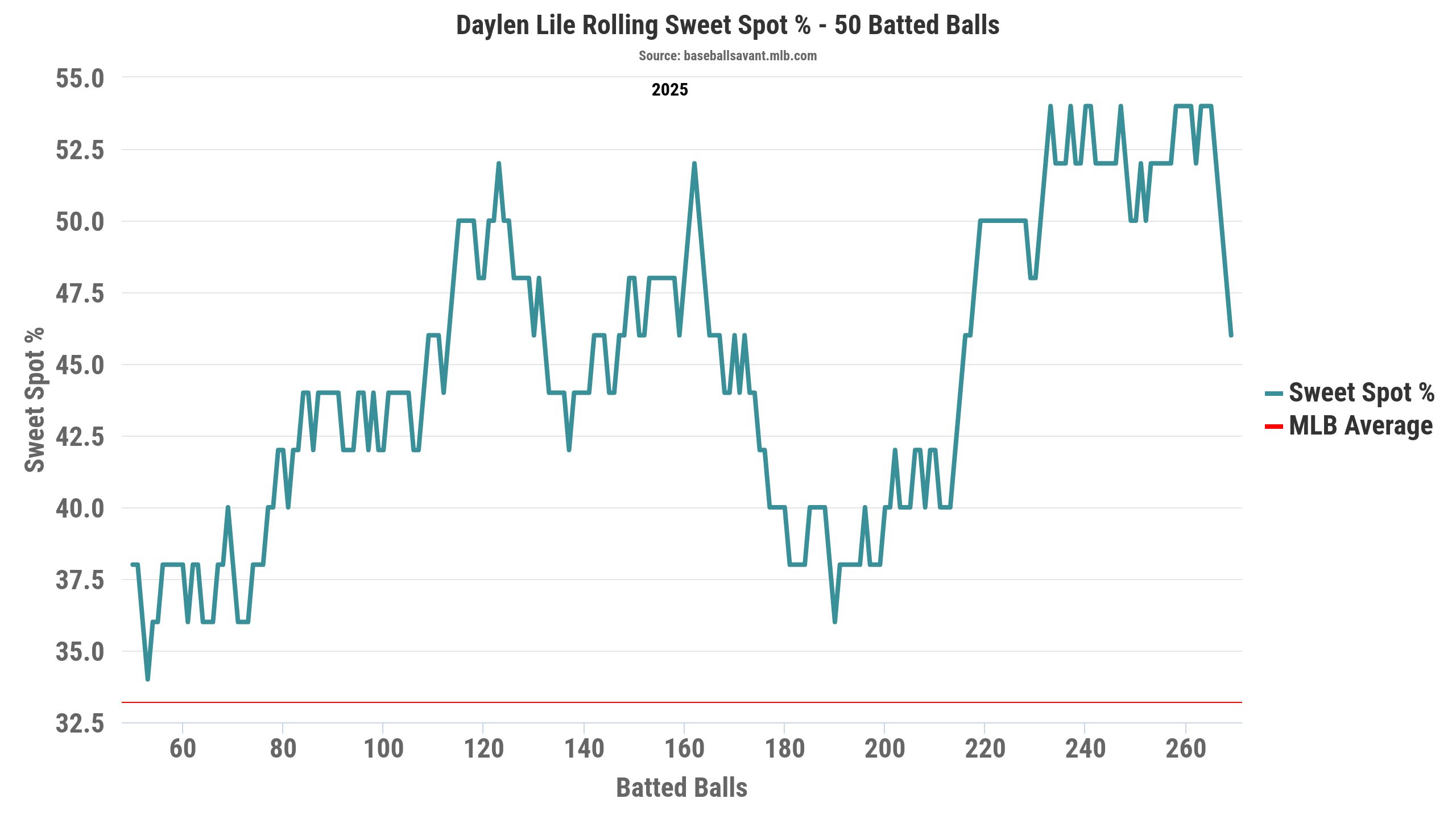Daylen Lile: P/G Gainer

Since the end of the season, I have been looking at players whose first– and second-halves were starkly different based on either points per game or points per inning pitched. We’ve covered one pitcher going each direction and a hitter who fell off a cliff, so today we turn our attention to a bat that broke out in the second half: Daylen Lile.
Lile is not the single-biggest gainer in P/G between the two halves of the season. He actually falls third and the other two are worth some attention, but I decided to table them for now. First is Shea Langeliers, who gained 4.33 P/G from 4.25 to 8.58. I am tabling him because, even without looking closely, you and I both know that Langeliers will be a highly-sought-after catcher in Ottoneu leagues (all fantasy leagues, really) this off-season. Second is George Springer, who went from 5.72 to 9.93 P/G, a jump of 4.21. I am tabling him because he is still playing and because even if the report is “the second half is a mirage, only trust his first half” well that first half was still really good!
And that brings us to Lile.
Daylen Lile – Gained 3.91 P/G, from 2.79 to 6.70
Lile stood out to me, in part because that jump took him from obvious cut to stud OF. If he had continued chugging along 2.79, it would have been easy to say he was worth a shot but the shot had failed and it was time to move on. Instead, he put up elite production in the second half of the season and has a starting role in the Nats OF pretty much locked down for 2026.
It’s worth noting that Lile, at 121 first-half PA, just did meet my threshold for inclusion in this piece. If he gets called up a week or so later, he isn’t even in this article. That is immediately something of a “good” sign. Without going any deeper, the second-half represents almost 2x as large a sample size. Not that we are going to stop there (this would be a very boring article if we did) but still – good to know!
That said, when you look at the full season with Lile, there are some things to like. Lile isn’t a big strikeout risk. He’s not crazy-elite at limiting strikeouts, but his 16% rate was tied for 50th among 277 players with 300+ PA this year. Being inside the top 20% of the league is a pretty good! He mostly avoids strikeouts by swinging aggressively in the zone (24th highest z-swing). He simply doesn’t take strikes. He’s basically middle of the pack (144th) in O-swing rate, so he’s not particularly patient – Lile is up there looking for his pitch and taking his hacks. That can be a profile for a high-K, low-BB power bat, but because Lile is 42nd in zone contact rate, he isn’t swinging through that many pitches, either.
What happens when you swing a lot and make contact a lot? Three things:
- You don’t strike out a ton. We covered that already.
- You don’t walk a ton, either. Lile is 214th with a 6.0% walk rate. His plate discipline numbers suggest he has a good sense of the strike zone (roughly 80th percentile z-swing rate vs. roughly 50th percentile o-swing rate), but he isn’t converting that to walks. He is converting it to…
- You put a ton of balls in play, which allows things like HR/FB rate and BABIP to have a heavy influence on your success. And boy does that stand out for Lile. In his miserable couple months in the majors, he had a 5.9% HR/FB rate and a .258 BABIP. Those numbers were 11.1% and .380 in the second-half. Yeah, that will go a long way towards explaining improved performance.
Big gains in HR/FB rate and BABIP could be noise and could be improved contact. With Lile, there is some improvement but it comes with a caveat.

As you can see from that graph, Lile’s hard hit rate did improve a bit. Kinda. He started well, cratered and then leveled off and that leveling off comes just about as the second half starts. But while that plateau is an improvement on his worst stretch, it isn’t like he pushed himself forward into some new tier of hard contact. And his rolling average EV chart is even flatter.
That could be a good thing, if his HH% and Avg EV were good. But they are not. He was 35th percentile in the former and 33rd in the latter. He had a 20th percentile barrel rate. The only other with a 30-40th percentile HH rate, 30-40th percentile EV, and 15-25th percentile barrel rate is Isaac Collins. If we expand our search a bit, allowing a 30th percentile barrel rate, we add Mike Tauchman. If we dip down further to a minimum 10th percentile barrel rate, we add Nick Gonzalez. We add Jake Cronenworth and Josh Lowe if we expand our EV percentile parameters t0 25-45th, and further expanding our HH rate percentile parameters to 25-45th, we add Ryan Jeffers, Trea Turner, Josh Naylor, Jared Triolo, and Brooks Lee.
That list isn’t devoid of talent, by any means, but it is also not super inspiring. And the most inspiring names – Turner and Naylor in particular – have much higher end max EVs and are better than Lile on all three of the numbers we started with.
So we have a guy who doesn’t hit the ball that hard, putting himself in company of some pretty unexciting fantasy hitters, and we don’t have any real clear evidence that he was improving in that area as the season went on. And yet, his wOBA jumped and that wasn’t all just noise:

That’s a pretty nice jump in xwOBA and even his season-long xwOBA (.353) was 76th percentile, way out of line with his hard contact measures. What drove that big improvement?

There you go – Lile started hitting the ball in ideal launch angles at a really high rate. His line drive rate, which was 23.2% in the first half, jumped to 30.1% in the second. How good is 30.1%? No qualified hitter was over 26% in the regular season this year. The highest number for a qualified hitter in the last five years is 29.4% from Adam Frazier in 2021. The highest sustained rate over 2+ seasons of PA (1200 or more) over the last five years is Luis Arraez at 26.6%. The top five in that stretch are Arraez, Frazier, Freddie Freeman, Donovan Solano, and Garrett Cooper. And the last two are at and below 25%.
At first glance, I see a guy who doesn’t hit the ball hard, doesn’t walk a ton, and gets his value from putting the ball in play and getting hits. When he ran a high BABIP, he scored points. When he didn’t, he didn’t. Which leaves you with the question: how much do you trust that BABIP?
For me, the answer is not very much. Line drive rate is a fickle stat; it takes 600 or more balls in play to stabilize. One player – Arraez – had over 600 balls in play this year. It takes a long time to get to that many balls in play unless you are just never striking out or walking. Lile had 270 batted ball events this year, per Statcast. Not all of those are balls in play, though. At this point, if you want to project his LD% going forward, you need to take a healthy dose of league average mixed in with his LD-rate to date. He is at 27.6% for the year; league average is 19.1%. It wouldn’t be unreasonable to set an over-under on his LD% at 24%.
While that all sounds quite negative, it is worth noting that a 24% line drive rate is still really high – remember 26% was league-leading in 2025. And while Lile doesn’t hit the ball super hard, he does hit it a lot harder than many of his natural comps. When you think elite contact rates, few K’s, not a ton of walks, spraying line drives, you probably picture the aforementioned Arraez, Kwan, and Frazier. And they aren’t bad comps for his plate discipline and bat control. But Lile’s hard hit and barrel rates, while far from elite, put that trio to shame.
As I look at Lile this off-season, I am not banking on him repeating his 2025 offensive performance. I think he’ll hit fewer liners and his BABIP will suffer, but if that leaves him as something like Steven Kwan with more bat speed, that’s a pretty interesting player. The thing is, we are now on year four of Kwan doing what Kwan does – line drive rate of 24.5% for his career (and better since his rookie year), while drawing walks, avoiding strikeouts, and turning his limited power into acceptable HR totals.
Lile, on the other hand, hasn’t even done his thing for one season. That makes it harder to bank on his floor – what if that line drive rate REALLY craters? But it also gives a lot more upside – what if he bulks up a bit, keeps his bat control, and suddenly barrels the ball at a much higher rate? That’s not a super likely outcome, but it isn’t impossible. There is a lot of risk here, but I am intrigued.
Lile is 86% rostered in Ottoneu and has a $5 median salary. If I can get him around that price, I am very happy to sit on him and see what he can do.
A long-time fantasy baseball veteran and one of the creators of ottoneu, Chad Young's writes for RotoGraphs and PitcherList, and can be heard on the ottobot podcast. You can follow him on Twitter @chadyoung.